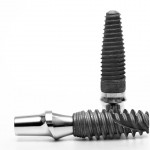
Insertion of dental implants is commonly associated with bone remodeling. A number of biological, technical and biomedical factors are considered to affect the degree of remodeling. The aim of this review was to assess the impact of implant– abutment configuration and the positioning of the machined collar/microgap on crestal bone level changes?
PubMed and the Web of Knowledge databases were searched together with the journals; Clinical Implant Dentistry and Related Research; Clinical Oral Implants Research; International Journal of Oral and Maxillofacial Implants; Journal of Clinical Periodontology; Journal of Periodontology. Only English language article published in peer reviewed journal were included. Animal or clinical (prospective randomized controlled or comparative) studies with histological or radiological assessment of bone levels were selected. Study quality was assessed using the ARRIVE and Consort Statement Guidelines.
- 13 papers were included and all were considered to be at high risk of bias.
- 3 animal and 2 human studies assessed the impact of different locations of the machined collar on crestal bone level changes. A meta-analysis of the 3 animal studies found a weighted mean difference (WMD) between machined collars placed either above or below the bone crest amounted to 0.835 mm favoring an epicrestal positioning of the rough/smooth border (P < 0.001).
- 5 animal and 1 human studies assessed the impact of the positioning of the microgap relative to the alveolar crest on bone remodeling. A meta-analysis using data from 4 animal studies found a WMD between microgaps placed either at or below the bone crest amounted to -0.479 mm favoring a subcrestal position of the implant neck (P < 0.001).
- One animal and one human study compared crestal bone level changes at different implant–abutment configurations (i.e. internal: flat vs. conical or external vs. internal)
The authors concluded
While the positioning of the machined neck and microgap may limit crestal bone level changes at non-submerged implants, the impact of the implant-abutment connection lacks documentation.
Comment
Only a small number of databases were used to conduct this review and it was restricted to papers published in English, this raises the possibility that some relevant papers could have been missed. Of the ones that were included only 4 were conducted in humans and all of the studies were considered to be at high risk of bias. Consequently the findings of this review should be treated with caution.
Links
Schwarz F, Hegewald A, Becker J. Impact of implant-abutment connection and positioning of the machined collar/microgap on crestal bone level changes: a systematic review. Clin Oral Implants Res. 2013 Jun 18. doi: 10.1111/clr.12215. [Epub ahead of print] PubMed PMID: 23782338.

Very interesting! Thanks.